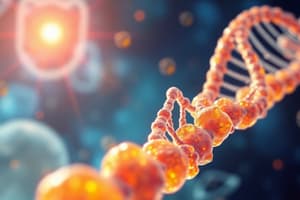Podcast
Questions and Answers
Which statement correctly describes the function of DNA polymerase during replication?
Which statement correctly describes the function of DNA polymerase during replication?
- It actively generates random DNA sequences.
- It triggers termination of the replication process.
- It ignores mismatched base pairs.
- It has proofreading activity which reduces errors. (correct)
During which phase of the cell cycle does DNA replication occur?
During which phase of the cell cycle does DNA replication occur?
- G1 phase
- M phase
- S phase (correct)
- G2 phase
What can result from errors in cell cycle regulation?
What can result from errors in cell cycle regulation?
- DNA damage and potential mutations (correct)
- Increased cellular growth rates
- Enhanced DNA repair mechanisms
- Precise DNA replication
What is the primary purpose of DNA repair mechanisms?
What is the primary purpose of DNA repair mechanisms?
What is the role of helicase in DNA replication?
What is the role of helicase in DNA replication?
Which enzyme is responsible for proofreading DNA during replication?
Which enzyme is responsible for proofreading DNA during replication?
In semiconservative replication, what does each new DNA molecule consist of?
In semiconservative replication, what does each new DNA molecule consist of?
What is the function of single-strand binding proteins (SSBs)?
What is the function of single-strand binding proteins (SSBs)?
During which phase of DNA replication is DNA synthesized continuously?
During which phase of DNA replication is DNA synthesized continuously?
What initiates DNA replication at the origins of replication?
What initiates DNA replication at the origins of replication?
What is the role of ligase during DNA replication?
What is the role of ligase during DNA replication?
What is the purpose of topoisomerase in the replication process?
What is the purpose of topoisomerase in the replication process?
Flashcards
Replication Termination
Replication Termination
The process of ending DNA replication at specific points on the DNA molecule.
Termination Sequences
Termination Sequences
DNA sequences that signal the end of DNA replication, stopping the replication machinery from proceeding further.
Proofreading Activity
Proofreading Activity
The ability of DNA polymerase to 'check' its work and correct any mistakes made during DNA synthesis.
DNA Repair Mechanisms
DNA Repair Mechanisms
Signup and view all the flashcards
S Phase
S Phase
Signup and view all the flashcards
DNA Replication
DNA Replication
Signup and view all the flashcards
DNA Polymerase
DNA Polymerase
Signup and view all the flashcards
Helicase
Helicase
Signup and view all the flashcards
Primase
Primase
Signup and view all the flashcards
Ligase
Ligase
Signup and view all the flashcards
Semiconservative Replication
Semiconservative Replication
Signup and view all the flashcards
Leading Strand
Leading Strand
Signup and view all the flashcards
Lagging Strand
Lagging Strand
Signup and view all the flashcards
Study Notes
DNA Replication Overview
- DNA replication is the process of creating two identical DNA molecules from a single original molecule.
- It's crucial for cell division and passing genetic information to daughter cells.
Key Enzymes Involved
- DNA polymerase: Adds nucleotides to the growing DNA strand, proofreads for errors.
- Helicase: Unwinds the DNA double helix, creating the replication fork.
- Primase: Synthesizes RNA primers for DNA polymerase to start replication.
- Ligase: Joins Okazaki fragments on the lagging strand.
- Single-strand binding proteins (SSBs): Prevent DNA strands from re-annealing.
- Topoisomerase: Relieves torsional strain ahead of the replication fork.
Mechanisms of Replication
- Semiconservative Replication: Each new DNA molecule has one original and one new strand. Maintains genetic fidelity.
- Leading Strand: Synthesized continuously in the 5' to 3' direction.
- Lagging Strand: Synthesized discontinuously in Okazaki fragments (5' to 3' direction, opposite of the replication fork). Joined by DNA ligase.
Replication Initiation
- Replication starts at specific sites called origins of replication.
- Eukaryotic chromosomes have multiple origins to speed up replication of large genomes.
- Initiation involves unwinding the DNA double helix and binding replication proteins.
Replication Elongation
- DNA polymerase adds nucleotides to the 3' end of the growing strand.
- The leading strand replicates continuously, the lagging strand discontinuously.
- The process continues as the replication fork moves along the DNA molecule.
Replication Termination
- Replication ends at specific termination sequences.
- These prevent replication machinery from colliding or causing errors.
- Termination ensures complete replication and accurate chromosome separation.
Errors and Repair
- DNA polymerase proofreads, minimizing errors.
- Occasional errors can still occur.
- DNA repair mechanisms correct mistakes (mismatched base pairs, damage).
Importance of Cell Cycle Regulation
- DNA replication occurs during the S phase of the cell cycle.
- Precise coordination with other cell cycle events is key for accurate replication and division.
- Errors in cell cycle control can cause DNA damage, mutations, and diseases (such as cancer).
Studying That Suits You
Use AI to generate personalized quizzes and flashcards to suit your learning preferences.




